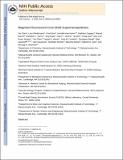Magneto-fluorescent core-shell supernanoparticles
Author(s)
Chen, Ou; Riedemann, Lars; Etoc, Fred; Herrmann, Hendrik; Coppey, Mathieu; Barch, Mariya; Farrar, Christian T.; Zhao, Jing; Wei, He; Guo, Peng; Cui, Jian; Chen, Yue; Wang, Zhongwu; Fukumura, Dai; Reimer, Rudolph; Dahan, Maxime; Jain, Rakesh K.; Bruns, Oliver Thomas; Cordero Hernandez, Jose M.; Jasanoff, Alan Pradip; Jensen, Russell A.; Harris, Daniel Kelly; Bawendi, Moungi G; ... Show more Show less
DownloadJasanoff_Magneto-fluorescent.pdf (1.716Mb)
OPEN_ACCESS_POLICY
Open Access Policy
Creative Commons Attribution-Noncommercial-Share Alike
Terms of use
Metadata
Show full item recordAbstract
Magneto-fluorescent particles have been recognized as an emerging class of materials that exhibit great potential in advanced applications. However, synthesizing such magneto-fluorescent nanomaterials that simultaneously exhibit uniform and tunable sizes, high magnetic content loading, maximized fluorophore coverage at the surface and a versatile surface functionality has proven challenging. Here we report a simple approach for co-assembling magnetic nanoparticles with fluorescent quantum dots to form colloidal magneto-fluorescent supernanoparticles. Importantly, these supernanoparticles exhibit a superstructure consisting of a close-packed magnetic nanoparticle ‘core’, which is fully surrounded by a ‘shell’ of fluorescent quantum dots. A thin layer of silica coating provides high colloidal stability and biocompatibility, and a versatile surface functionality. We demonstrate that after surface pegylation, these silica-coated magneto-fluorescent supernanoparticles can be magnetically manipulated inside living cells while being optically tracked. Moreover, our silica-coated magneto-fluorescent supernanoparticles can also serve as an in vivo multi-photon and magnetic resonance dual-modal imaging probe.
Date issued
2014-10Department
Massachusetts Institute of Technology. Department of Biological Engineering; Massachusetts Institute of Technology. Department of Brain and Cognitive Sciences; Massachusetts Institute of Technology. Department of Chemistry; Massachusetts Institute of Technology. Department of Nuclear Science and EngineeringJournal
Nature Communications
Publisher
Nature Publishing Group
Citation
Chen, Ou, Lars Riedemann, Fred Etoc, Hendrik Herrmann, Mathieu Coppey, Mariya Barch, Christian T. Farrar, et al. “Magneto-Fluorescent Core-Shell Supernanoparticles.” Nat Comms 5 (October 9, 2014): 5093.
Version: Author's final manuscript
ISSN
2041-1723